Archive for August 28th, 2020
2020 Solidarity born 40 years ago
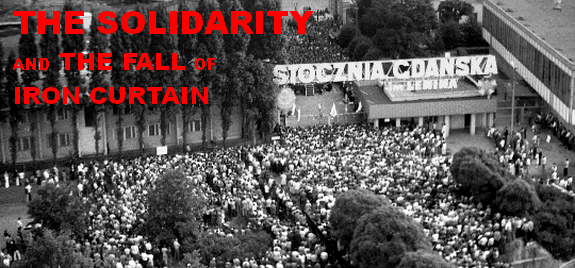 Online exhibit: THE SOLIDARITY AND THE FALL OF THE IRON CURTAIN
Online exhibit: THE SOLIDARITY AND THE FALL OF THE IRON CURTAIN
Wystawa wirtualna: Solidarność i upadek żelaznej kurtyny
Background image: Gdańsk Shipyard during the strike in August 1980
Photo by Tomasz Michalak/FOTONOVA from the collection of Polish History Museum
The Amazing Story of Solidarity Begins
– 40 Years Ago
Remarks by Prof. Emeritus Donald Pienkos
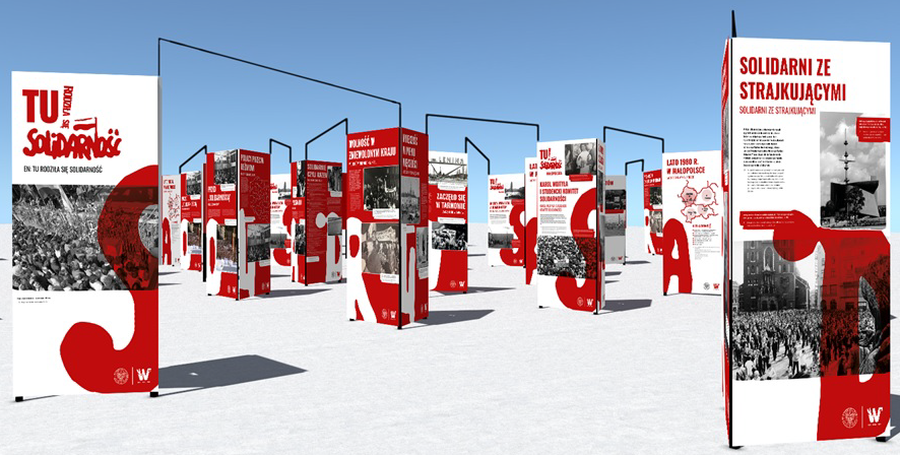
August 28, 2020: From the Institute of National Remembrance (Instytut Pamięci Narodowej),
“This is where ‘Solidarity’ was born” exhibit officially opens in Warsaw’s Piłsudski square – but displayed in 53 locations all over Poland since July.
August 29, 2020: Niagara Falls lit white and red to celebrate the birth of Solidarity on August 31, 1980
(captured from the Clifton Hill Live Cam feed)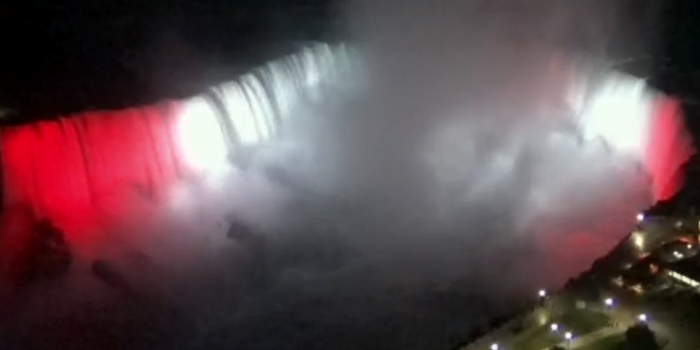
On August 14, 1980 the Solidarity trade union – Solidarność – was conceived in the Lenin Shipyard in Gdansk, Poland. Founded by working men and women, it quickly mushroomed into a nationwide non-violent movement of nearly 10 million members committed to workers rights, freedom, and social justice in the midst of a great and continued economic crisis.
Solidarity’s amazing story is rooted in the Polish people’s frustration with the failed policies of the communist regime imposed on their country by Soviet Russia after World War II and in their response to the visit to his beloved homeland by Pope John Paul II in June 1979. There he told the millions who saw and heard him, “Be not afraid.” Be true to yourselves and your time honored values.
Nonetheless following his departure to the Vatican, Poland’s downward economic spiral only worsened. In response, the regime ordered steep increases in food prices in July 1980 – a move that led to workers’ sit down strikes across the country. Faced with their legitimate demands for wage increases to cushion the price hikes, demands in response to a crisis they had nothing to do with causing, the regime caved in everywhere.
Some Selected Key Dates in the Solidarity Story
August 14, 1980 The Solidarity movement is born in the Lenin Shipyards of Gdansk
August 31, 1980 The Union’s 21 Point program, including Solidarity’s independence, is accepted
September 1980 The Solidarity Union’s charter receives official state recognition
March 1981 A Regime-sponsored effort occurs in Bydgoszcz aimed at breaking the Union
September 1981 First Solidarity national convention – Walesa is elected chair; the delegates call for Solidarity-like unions in the Soviet Union and East Europe!
November 4 1981 Party leader Jaruzelski, Walesa and Cardinal Glemp meet to end the crisis but fail when Jaruzelski rejects any genuine power sharing proposals
December 12, 1981 Martial law is proclaimed; the United States imposes Sanctions on Poland and the USSR
October 1982 The Parliament dissolves Solidarity; Martial Law officially ends in December
June 1983 Pope John Paul II’s second visit to Poland; Martial Law is lifted in July
July 1984 A first major regime amnesty of political prisoners is declared February 1987 U.S. lifts sanctions but Jaruzelski still refuses to recognize Solidarity
April-August 1988 Virulent strikes break out in Nowa Huta (Krakow), Gdansk, and the coal mines February 6, 1989 Roundtable talks begin in Warsaw
April 5, 1989 Solidarity is restored to full legal status
June 4, 1989 Semi-free Parliament elections result in an overwhelming Solidarity victory September 1989 A Solidarity-led government is approved by Parliament
At the Gdansk Shipyards, where 15,000 men and women were employed, workers went beyond wage demands to protest the firing of a respected co-worker, Anna Walentynowicz – just months before she was to retire. Another indiviual, Lech Walesa, a former worker blacklisted for his independent labor union organizing activities, joined them and was immediately made a leader of its strike com-mittee. Two days later the committee won its wage demands and Walentynowicz and Walesa were reinstated. At this point, the committee received appeals to give its support to strikers in other Baltic seacoast enterprises. An interfactory strike committee headed by Walesa was set up, with new demands calling for the creation of an independent union and a union newspaper free of government censorship. Solidarnosc was born.
The Communist party sent a high ranking government emissary to Gdansk to meet with the Strike committee. But he found himself facing not only a determined shipyards committee but one bolstered by advisors from Warsaw who had courageously backed workers’ rights in the past. On August 31, 1980, after days of tense talks, during which 640,000 workers had gone on strike around the country, an agreement was at last reached. All of Solidarity’s demands were accepted – including its right to be an independent, self-governing, labor union.
This unimagined agreement sparked Solidarity’s amazing expansion into a massive national force that grew in just a few weeks to nearly ten million members. By then a new Party leadership that included Defense Minister Wojciech Jaruzelski was also in place. But months of frustrating tension-filled delays followed, with anti-Solidarity party and government leaders backed by the Soviet Union doing all they could to oppose the Union. And as Poland’s economic conditions worsened, they fixed the blame on Solidarity. Moreover, behind the scenes, General Jaruzelski had put together a martial law plan to suppress the movement.
On December 12, 1981, after 16 months of crisis, Jaruzelski imposed martial law, claiming he acted to prevent a civil war. His perfectly executed plan resulted in the jailing of 9,700 Solidarity leaders and the union’s suppression. In response, the United States imposed severe economic sanctions on Poland and began covertly supporting those Solidarity activists who had escaped arrest. This effort, along with those of John Paul II, helped keep the Solidarity cause alive. For its part, Jaruzelski’s military-dominated regime failed to destroy the Solidarity idea, to build support for its rule, and to revive Poland’s distressed economy. At last, faced with renewed worker unrest, the General, with Soviet leader Mikhail Gorbachev’s blessings, began “Roundtable talks” with Solidarity representatives to try to find a way out of the crisis which by then had gone on for more than a decade. These talks opened in Warsaw on February 6, 1989.
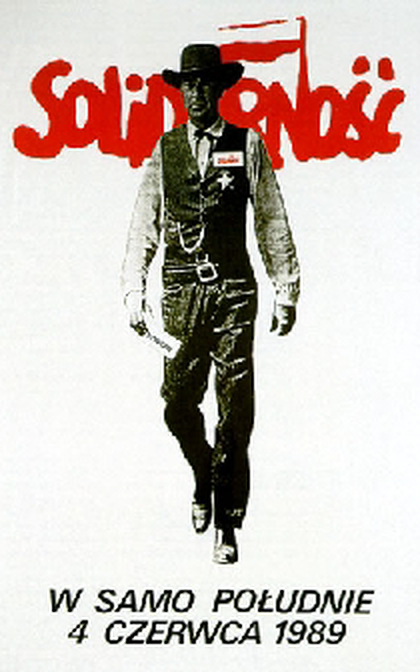
The iconic “High Noon” (W samo południe) poster urging people to vote in 1989 election (created by Tomasz Sarnecki)
The Roundtable, while controversial to this day, brought Solidarity’s restoration on April 5, 1989 and a special election to the Polish parliament on June 4. This election, while only partly free, saw Solidarity win an incredibly overwhelming victory. Of the 261 freely elected candidates, not a single one was won by a regime nominee. Moreover, even communist party nominees running unopposed lost when over half of the voters crossed their names off the ballots! The Party’s humiliation was so complete that it was obliged, with Gorbachev’s approval, to reluctantly accept a Solidarity-led government.
Headed by Tadeusz Mazowiecki, this new government was approved in September 1989. In December, the Parliament ended the “People’s Poland” system and proclaimed a new, democratic Polish Republic. In January 1990, the Polish communist party dissolved. By then Soviet rule over Hungary, Bulgaria, Czechoslovakia, East Germany and Romania was over and the infamous Berlin Wall had fallen. What began in Gdansk in August 1980 would culminate with the disintegration of the Soviet Union itself in 1991 and the end of the Cold War.
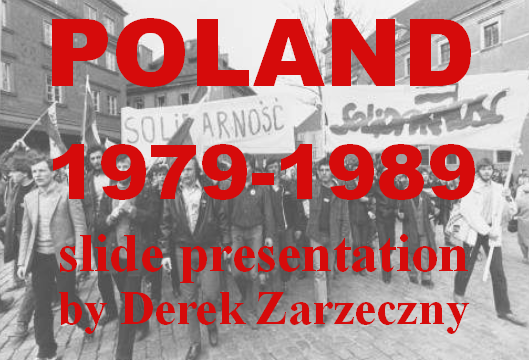
From the panel discussion “Poland 1979-1989: Living through Poland’s Extraordinary Decade: Memories from Members of Our Community” held by the Polish American Congess Wisconsin Division on April 22, 1980 comes the above slide show presented by Derek Zarzeczny.
Polish Americans backed Solidarity. Indeed, the Polish American Congress, American Polonia’s civic action voice, had called its demands “fully justified” – only days after its creation. In December 1981, PAC leaders were in the White House to join with President Reagan in condemning martial law. In 1985, the PAC led the protest in New York City objecting to Jaruzelski when he headed a delegation to the United Nations to mark its 40th anniversary. In September 1989 PAC and Polish American community leaders were in Poland to give their support to Prime Minister Mazowiecki’s new Solidarity government. In October 1989 the PAC and Polonia welcomed Lech Walesa to Chicago just days after his stirring speech to the U.S. Congress. And in the years after American Polonia both strongly backed U.S. aid to Poland and Poland’s entry into the NATO Alliance.
Solidarity, an inspired and inspiring non-violent movement of “ordinary” people who were anything but ordinary, helped usher in a new post Cold War world – a world we have been blessed with for more than thirty years.*
*The contributions of countless Solidarity acticists can be found in works like those of Andrzej Paczkowski: Revolution and Counterrevolution in Poland, 1980-1989 (2015) and Antoni Dudek: The Road to Independence: Solidarnosc (2000).
Archived Posts
- 2023 Merry Christmas
- 2023 Lighting the Light of Freedom on Dec 13 at 7:30pm
- Independence Day and Veteran Day invitation
- 2023 Wianki Festival
- 2023 May 3rd Constitution Day Celebration
- 2023 Lecture on Polish Borders by Prof. Don Pienkos
- 2023 REMEMBER THIS: Jan Karski movie premieres on PBS Wisconsin
- 2023 Upcoming lectures in the Polish Center of Wisconsin
- 2022 Polish National Independence Day
- 2022 Independence and Veteran Day Luncheon (invitation)
- 2022 Wianki, Polish Celebration of Noc Świętojańska (St. John’s Night)
- Celebrating Constitution of May 3, 1791 in Polish Center of Wisconsin
- 2022 Polish Constitution Day, Polish Flag Day and the Day of Polonia
- 2022 March Bulletin
- 2022 Polonia For Ukraine Donations
- 2022 Polish American Congress Condemns Russian Invasion of Ukraine
- 2022 PAC-WI State Division Letters to WI Senators and Representatives
- 2021 Polish Christmas Carols
- 2021 Panel Discussion: Martial Law in Poland 1981-1983 (REPORT)
- 2021 Panel Discussion: Martial Law. Poland 1981-1983 (invitation)
- 2021 Solidarity: Underground Publishing and Martial Law 1981-1983
- 2021 Polish Independence Day and Veterans Day
- 2021 Polish Independence Day and Veterans Day Luncheon
- 2021 Prof. Pienkos lecture: Polish Vote in US Presidential Elections
- 2021 POLISH HERITAGE MONTH EVENTS
- 2021 “Freedom” Monument Unveiled in Stevens Point, Wisconsin
- 2021 PCW Picnic and Fair
- 2021 Remembering Września Children Strikes (1901-1903)
- 2021 May 3 Constitution Day
- 2021 DYKP Contest Winners and Answers
- 2021 DYKP CONTEST EXTENDED and CASIMIR PULASKI DAY
- 2021 February announcements
- 2021 Polish Ministry of Education and Science oficials visit Wisconsin
- 2021 DYKP Contest, KF Gallery and Dr. Pease lectures
- 2020 Help Enact Resolution commemorating the 80th Anniversary of the Katyn Massacre
- 2020 Independence And Veterans Day
- 2020 Remembering Paderewski
- 2020 POLISH HERITAGE MONTH
- 2020 Solidarity born 40 years ago
- 2020 Battle of Warsaw Centenary
- 2020 The Warsaw Rising Remembrance
- 2020 June/July News: Polish Elections, Polish Films Online and more
- 2020 Poland: Virtual Tours
- Centennial of John Paul II’s Birth
- 2020 Celebrating Polish Flag, Polonia and Constitution of May 3rd
- 2020 Polish Easter Traditions
- 2020 Census and Annual Election
- Flavor of Poland (Update 3)
- 2020 Copernicus, Banach & Enigma talk
- 2020 Do You Know Poland and other announcements
- 2020 Flavor of Poland (Update 2)
- 2020 People and Events of the Year
- 2019 Holidays
- 2019 December Medley
- 2019 Independence Celebration
- 2019 Independence Invitation
- 2019 WI Study in Poland Reports
- Lecture: Poland’s Entry Into the NATO
- August 2019 anniversaries
- 2019 Polish Fest
- Celebrating Polish Constitution and Ignacy Paderewski
- WSIP 2018 Reports (Wisconsin Study in Poland)
- 2018 Christmas Carols
- 2018 Polish Independence and Veterans Day
- November 2018 events
- October 2018 Events
- 2018 Kashube Lecture Notes
- September 2018 events
- 2018 Polish Fest Report
- Upcoming 2018 Polish Fest
- Celebrating Polish Constitution Day
- Poland 1979-1989 (panel discussion)
- Protest the Passage of S.447 in the U.S. House of Representatives


